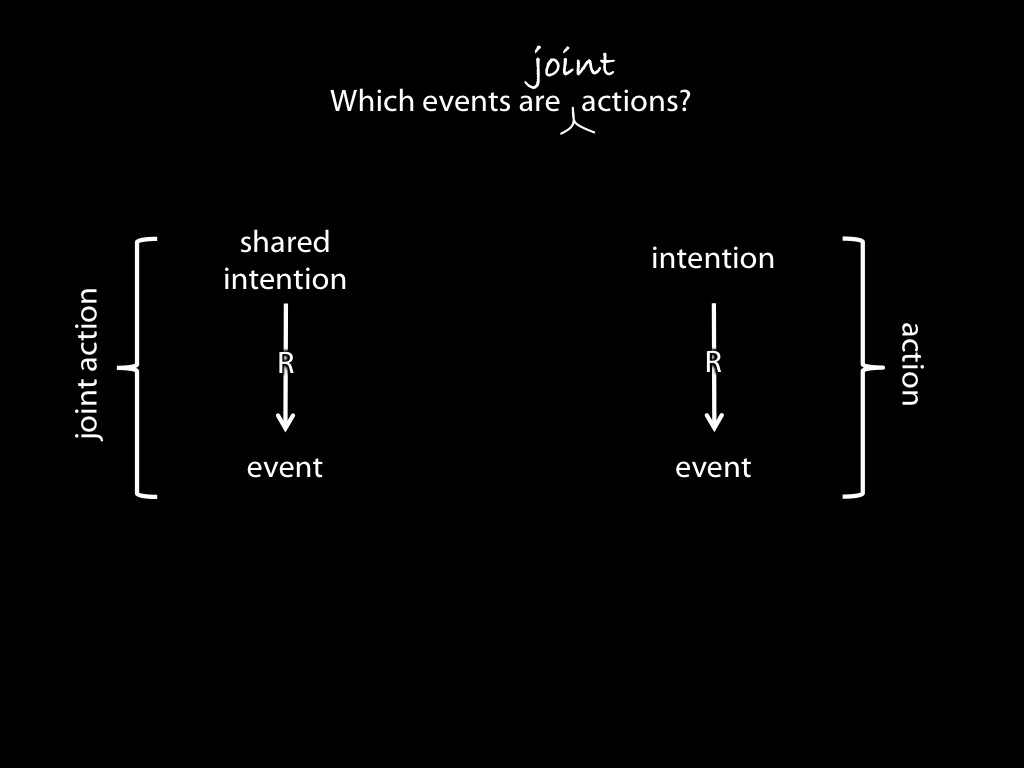Click here and press the right key for the next slide (or swipe left)
also ...
Press the left key to go backwards (or swipe right)
Press n to toggle whether notes are shown (or add '?notes' to the url before the #)
Press m or double tap to slide thumbnails (menu)
Press ? at any time to show the keyboard shortcuts

\def \ititle {Lecture 05}
\def \isubtitle {Joint Action}
\begin{center}
{\Large
\textbf{\ititle}: \isubtitle
}
\iemail %
\end{center}
\section{Aggregate Animals, Aggregate Subjects}
What are aggregate subjects?
I suggest we think of them on the model of aggregate animals such as Physalia Physalis.
But how can such a thing as an aggregate subject exist?
Humans do not mechanically attach themselves in the way that the polyps and other animals
making up Physalia Physalis do.
So how are aggregate agents possible?
On accounts like Bratman’s or Gilbert’s, ‘it makes some sense to say that the result is a kind of shared action: the individual people are, after all, acting intentionally throughout.
However, in a deeper sense, the activity is not shared: the group itself is not engaged in action whose aim the group finds worthwhile, and so the actions at issue here are merely those of individuals.
Thus, these accounts ... fail to make sense of a ... part of the landscape of social phenomena’
\citep[pp.~20--1]{helm_plural_2008}
Helm (2008, pp. 20-1)
Start with Helm’s challenge ([because I can answer it at the end]).
This is bad: who can explain what sharing amounts to? This is just a metaphor.
Our problem is to discipline the metaphor, not to write as if we already understood it.
It is hard to understand what Helm is aiming for here, but I think the idea is that
the actions should be not merely those of individuals but of the group itself.
The objection says something is missing, but actually our interest is driven
by the thought that both Gilbert’s and Bratman’s approaches are inadqeuate
as attempts to characterise shared agency.
How to make sense of this idea?

aggregate subject
I think Helm wants what I will call an ‘aggregate subject’.
(He uses the term ‘plural robust agent’, but this is because he ignores
a distinction between aggregate and plural subjects which will be important later.)
Meet an aggregate animal, the Portuguese man o' war (Physalia physalis),
which is composed of polyps.
Here you can say that ‘the group [of polyps] itself’ is engaged in action
which is not just a matter of the polyps all acting.
To illustrate, consider how it eats.
Wikipedia: ‘Contractile cells in each tentacle drag the prey into range of the
digestive polyps, the gastrozooids, which surround and digest the food by secreting
enzymes that break down proteins, carbohydrates, and fats, while the gonozooids are
responsible for reproduction.’
This jellyfish-like animal is a crude model for the sort of aggregate agent Helm (and others)
suggest we need.
But how can such a thing exist?
Humans do not mechanically attach themselves in the way that the polyps
making up that jellyfish-like animal do.
So how are aggregate agents possible?

Joint Commitment and Shared Intention
\section{Joint Commitment and Shared Intention}
According to Gilbert, ‘joint commitment underlies a host of central social phenomena in the human
realm’ and it is a ‘precondition of the correct ascription’ of acting together, collective
belief, shared intention, and more’ (2013, p. 9). What does she mean?
‘joint commitment underlies a host of central social phenomena in the human realm’;
\citep[p.~400]{gilbert:2014_book}
Gilbert (2013, p. 400)
it is a ‘precondition of the correct ascription’ of acting together, collective belief, shared intention, and more’
\citep[p.~9]{gilbert:2014_book}
Gilbert (2013, p. 9)
The overarching question for the course is:
Which forms of shared agency underpin our social nature?
The first problem, with which we are still grappling, is how to get a
basic fix on shared agency.
Here sharing is a metaphor, suggestive and romantic but not conducive
to the kind of serious theorising that might eventually support research
into how interactions and societies actually work.
Indeed, loose talk about sharing allows lots of philosophers to construct all kinds
of theories, each slightly different from the next, none of which seems to work.
I suggested that we can use the method of contrast cases to as a rough and ready
criterion for success. That is ...
There are these contrasts between joint action and parallel but merely
individual action. For example ...
Parallel but Merely Individual Action
Two people making the cross hit the red square in the ordinary way.
Beatrice & Baldric’s making the cross hit the red square
Two sisters cycling together.
Two strangers cycling the same route side-by-side.
Members of a flash mob simultaneously open their newspapers noisily.
Onlookers simultaneously open their newspapers noisily.
To earn the right to theorise about shared agency
Question
What distinguishes genuine joint actions from parallel but merely individual actions?
This is not the question we ultimately want to answer, but it is a question that
we must answer as a preliminary to doing anything else.
To earn the right to talk about shared agency, we have to answer this question.
The contrast cases show that this question isn’t easy
to answer because the most obvious, simplest things you might appeal to---coordination
and common effects---won’t enable you to draw the distinction.
In fact, the first contrast cases shows that even some complex things you might appeal to---such
as the structure of intentions and knowledge states which Bratman offers in his account of
shared agency---don’t enable you to draw the distinction.
Our interest in Gilbert is that she might provide the resources to answer this question.
Do we need joint commitment to distinguish genuine joint actions from parallel but merely
individual actions?
the ‘shared intention’ strategy
The failure of the Simple View motivates what I will call the ‘shared intention’ strategy,
which practically everyone accepts.
According to the shared intention strategy, an account of shared agency consists in
an account of shared intention plus an account of how an event must be connected to
a shared intention in order to count as a joint action.
This position is widely endorsed.
‘the key property of joint action lies in its internal component [...] in the participants’ having
a “collective” or “shared” intention.’
\citep[pp.~444--5]{alonso_shared_2009}
(Alonso 2009, pp. 444-5)
But what is shared intention?
This is our current question.
There is much disagreement.
But one thing everyone seems to accept:
Shared intention stands to joint action as
ordinary, individual intention stands to ordinary individual action.
This is, of course, not a theory but a rough starting point.
It is however worth noting some constraints on theories of shared intention.

So the idea is that shared intention is to joint action as intention is to ordinary, individual
action.

Of course, invoking shared intention doesn’t by itself amount to explaining anything. It simply
takes us in a circle. (Which is not necessarily bad.)
To characterise joint action, we have two tasks: (i) characterise shared intention; (ii) characterise
a relation between shared intentions and events such that the events are joint actions.
Can we use joint commitment to characterise shared intention?
First we have to examine a further feature of joint commitment which I have not yet mentioned ...
Gilbert: joint commitment
‘a commitment
by two or more people
of the same two or more people.’
Contrast personal commitment (by me, of me)
joint commitment is ‘the collective analogue of a personal commitment’
Gilbert (2013, p. 85)
Contrast contralateral commitment (by me, of me, to you)
But there’s something I didn’t tell you about joint commitment yet ...

Gilbert: All joint commitments are commitments to emulate, as far as possible, a single body which does something (p. 64).
‘Any joint commitment can be described in a statement of the following form:’
‘A, B, and so on (or those with property P) are jointly committed as far as is possible (by virtue of their several actions) to emulate a single doer of X’.
\citep[p.~311]{gilbert:2014_book}
On emulation: I guess there is a singular version: an actor emulates a
single body which believes that $p$, intends to $\phi$, and so on.
Likewise, two actors might for some reason share the role (perhaps a
young one and an old one).
(Here there is not necessarily any joint commitment, but there are
commitments with the contents of those which Gilbert specifies as joint commitments.)
‘What is a “single body” [...]?
whereas a single human being constitutes a single body [...],
a plurality of human individuals does not in and of
itself constitute such a body. [...] however,
such a plurality can emulate such a body—one with a plurality not
only of limbs, eyes, and ears, but also of noses and mouths’
\citep[p.~116]{gilbert:2014_book}
Gilbert (2013, p. 116)
I love the seemingly random ‘not
only of limbs, eyes, and ears, but also of noses and mouths’.
‘a “body” here is understood to be a non-collective body.’
BUT: ‘some of the things we may share an intention to do are designed for two or more participants
... Sally and Tim are jointly committed to intend as a body to produce, by virtue of the
actions of each, a single instance of a tennis game with the two of them as participants in
that game’ (Gilbert 2013, p. 117)
Why does Gilbert insist on the form?
I don’t think it adds anything to our understanding of joint commitment as such.
But it is essential to Gilbert’s use of joint commitment to analyse social phenomena.
Earlier I asked how there might be such a thing as an aggregate agent.
Now I think we can sort of see one possibility.
Could aggregate agents come about because we commit to emulating a single body?

Gilbert: All joint commitments are commitments to emulate, as far as possible, a single body which does something (2013, p. 64).
In manifesting any collective phenomenon, we can truly say ‘We have created a third thing, and each of us is one of the parts’
\citep[p.~269]{gilbert:2014_book}
Gilbert (2013, p. 269).
The collective value, belief or intention or whatever is primarily a value, belief or intention
of this third thing.
What is this third thing?
I take it to be the single body we have emulated
in doing many things together, the point of doing them together is
precisely not to emulate a single body: e.g. in lifting a table, or
in foraging for berries, two bodies allow strategies that are
impossible with just one body
Emulating as far as possible a single body
that intends to wash up is not generally the most efficient way for
several people to get the washing up done—Andrea and Heinrich had better
exploit the fact that they are two than pretend to be an aggregate
animal. The ‘emulating a single body’ form also seems to rule a shared
intention to make out after washing up. And if it doesn’t preclude
shared intentions to tango outright, it has unfortunate stylistic
consequences in implying that those with such intentions are jointly
committed to emulate a single body that intends to tango.
What is the motivation for this claim?
If, as Gilbert holds,
joint commitments are all commitments to emulate a single body which
does something, then the thing to which there is commitment involves
nothing collective. Joint commitment thus serves, for Gilbert, as a
device which transforms ordinary, singular phenomena (intention, belief
or whatever) into collective phenomena with added commitments. To this
extent Gilbert’s programme is reductionist: shared values, collective
beliefs and the rest are reduced to joint commitments plus ordinary,
individual values, beliefs and the rest.
Gilbert’s reductionism
Why does everything but joint
commitment require reduction?
So Gilbert’s analysis of joint commitment actually has two parts.
Gilbert on joint commitment
[1] The subject:
‘a commitment
by two or more people
of the same two or more people.’
[2] The content:
All joint commitments are commitments to emulate, as far as possible, a single body which does something (2013, p. 64).
acting together
Gilbert says several things about acting together which I have argued against in
this or a previous lecture. In particular, I reject her claims that:
1. Acting together invariably involves shared intention.
2. Acting together invariably involves commitment (I think contralateral commitments
are associated with shared intentions, and not directly with joint actions).
3. We know that contralateral commitments exist in virtue of shared intentions.
For this reason I will confine myself to her analysis of shared intention,
which I think is independent of what she says about acting together.
shared intention
Actually Gilbert explicitly equates goals with intentions,
whereas I think they are importantly different.
(More on this later.)
For us to have
a shared intention that we φ
is for us to be jointly committed
to emulate a single body
which
intends to φ
What can be said in favour of this view?
Gilbert offers several considerations.
Here I’ll mention two; the disjunction criterion and the point about commitment in virtue of
intentions.
The Disjunction Criterion
‘when two or more people share an intention, none of them need to have a contributory intention.’
\citep[p.~103]{gilbert:2014_book}
Gilbert (2013, p. 103)
I take it Gilbert would endorse a parallel claim about intention.
Compare blocking
two or more people collectively block an asile, none of them need to individually block an asile.But: collective vs shared!
I already mentioned this earlier, in a different context.
‘When people regard themselves as collectively intending to do something,
they appear to understand that, by virtue of the collective intention, and that alone,
each party has the standing to demand explanations of nonconformity [...].
A joint commitment account of
collective intention respects this fact. ’
Gilbert (2013, pp. 88–9)

I started by mentioning Gilbert’s proposal that ...
‘joint commitment underlies a host of central social phenomena in the human realm’;
\citep[p.~400]{gilbert:2014_book}
Gilbert (2013, p. 400)
it is a ‘precondition of the correct ascription’ of acting together, collective belief, shared intention, and more’
\citep[p.~9]{gilbert:2014_book}
Gilbert (2013, p. 9)
I think the basis for this proposal is her analysis of shared intention in terms of
joint commitment.
How successful is that analysis?
To consider this question, let’s return to the contrast cases ...
There are these contrasts between joint action and parallel but merely
individual action. For example ...
Parallel but Merely Individual Action
Two people making the cross hit the red square in the ordinary way.
Beatrice & Baldric’s making the cross hit the red square
Two sisters cycling together.
Two strangers cycling the same route side-by-side.
Members of a flash mob simultaneously open their newspapers noisily.
Onlookers simultaneously open their newspapers noisily.
In favour of Gilbert’s account, a joint commitment to emulate a single body that intends that ...
appears absent from the cases of parallel but merely individual action.
The challenge, I think, concerns the necessity of Gilbert’s account. Must sisters cycling
together have a joint commitment to emulate a single body that intends to cycle to school?
Maybe---we should evaluate Gilbert’s arguments for her position.

Joint and Contralateral Commitment: Objection to Gilbert on Shared Intention
\section{Joint and Contralateral Commitment: Objection to Gilbert on Shared Intention}
Do joint commitments explain contralateral commitments?
For us to have
a shared intention that we φ
is for us to be jointly committed
to emulate a single body
which
intends to φ
Gilbert offers several arguments in favour of this position which I encourage you to review
if you are exploring it (and certainly before rejecting it).
However, I want to concentrate on just one argument ...
I already mentioned this earlier, in a different context.
‘When people regard themselves as collectively intending to do something,
they appear to understand that, by virtue of the collective intention, and that alone,
each party has the standing to demand explanations of nonconformity [...].
A joint commitment account of
collective intention respects this fact. ’
Gilbert (2013, pp. 88–9)
1. Shared intentions are associated with contralateral commitments.
2. This is a fact which stands in need of explanation.
3. That shared intentions are joint commitments (to emulate a single body which intends to ...) explains this fact.
Recall what a joint commitment is ...
Gilbert: joint commitment
‘a commitment
by two or more people
of the same two or more people.’
joint commitment is ‘the collective analogue of a personal commitment’
Gilbert (2013, p. 85)
Contrast contralateral commitment (by me, of me, to you)
joint vs contralateral
- compare -
orgy vs reciprocal
we teach ourselves to code vs we teach each other to code
The first thing we want joint commitments for is to explain contralateral commitments.
Allow me to recap ...
Observation: shared intentions are associated with contralateral commitments.
Question: What is their source?
- individual intentions? no!
- conditional intentions? no!
- joint commitments? no!
So our first reasons for being interested in joint commitments is that they
might turn out to be the grounds for the existence of contralateral commitments.
But are they?
‘Once the idea of joint commitment has been clarified, one may find it obvious that
the parties to any such commitment … owe each other such actions in their capacity
as parties to the joint commitment’
\citep[p.~400-1]{gilbert:2014_book}
‘What each is committed to, through the joint commitment, is to do his
part [...] These actions are owed solely by virtue of the
existence of the joint commitment’
\citep[pp.~401--2]{gilbert:2014_book}
‘just as—in the case of a personal commitment—you are in a position to
berate yourself for failing to do what you committed yourself to do,
all of those who are parties with you to a given *joint* commitment
are in a position to berate you for failing to act according to that
joint commitment’ (p. 401).
\citep[p.~401]{gilbert:2014_book}
Gilbert (2013, p. 401)
Isn’t this a more accurate parallel: parties to a joint commitment are
in a position to jointly berate themselves for failing to act according
to the joint commitment? It doesn’t follow from this, of course, that
any individual has the standing to berate, nor that any individual can
be berated. Aren’t shared commitments more plausibly a source of
directed obligations than joint commitments?
Let me explain this further ...
Collective entails individual?
- blocking: no
- state of disarray: no
- blame: no?
Let me pause over blame because this is quite intuitive and will be useful
later (when we contrast collective with shared)
Let us return to Gilbert’s argument for her account of shared intention ...
For us to have
a shared intention that we φ
is for us to be jointly committed
to emulate a single body
which
intends to φ
‘When people regard themselves as collectively intending to do something, they appear to understand that, by virtue of the collective intention, and that alone, each party has the standing to demand explanations of nonconformity [...]. A joint commitment account of collective intention respects this fact.’
Gilbert (2013, pp. 88–9)
I think Gilbert is actually wrong about this ... or at least she has provided no argument
for this claim.
(This does not establish that her account of shared intention is wrong, of course.
But I think it removes a key reason to attempt to defend it.
For my part, I cannot identify any considerations which favour invoking joint commitments in
explaining shared intention.)
So in terms of the argument presented earlier, ...
1. Shared intentions are associated with contralateral commitments.
2. This is a fact which stands in need of explanation.
3. That shared intentions are joint commitments (to emulate a single body which intends to ...) explains this fact.
I reject the third claim.
So where have we got to? I claim that claims 1 and 2 are inconsistent, as are claims 1 and 3.
(Claim 2 was considered in Lecture 04; several people disagreed.)
1. A joint commitment is a commitment we have collectively.
(So joint commitment is a commitment.)
2. Gilbert shows joint commitments exist.
3. Joint commitments ground contralateral commitments.
I have no idea which claims we should reject.
4. Shared intentions are joint commitments to emulate a single body that intends ...
Unless we reject 2 and 3, Gilbert is so catastrophically wrong that it seems
we must have misunderstood her.
Further some philosophers and some psychologists accept Gilbert’s view;
e.g.:
‘We agree with Gilbert that joint action goes, intuitively, with the sort of joint commitment that she describes.’
\citep[p.~32]{pettit:2006_joint}
On the other hand, you could take a completely different view.
You might say Gilbert is not radical enough and that joint commitments
allow us to make sense of plural subjects in a more robust sense than
interests her. You might say, the point of joint commitments isn’t to allow
us to make sense of the contralateral commitments, but to allow us to make
sense of the idea that commitments and mental states can be had by collectives.
But if we don’t reject 2 and 3, it seems we must reject 1, and without this
it seems we have no idea what joint commitments could be.
This is also implausible; surely Gilbert has explained this.
To be honest I suspect that I am missing something.
But I have no idea what it is.
In any case, I want to finsih with a quick look at how Gilbert
applies her account of joint commitment.
If the applications seem illuminating, that would motivate further
consideration of her research.
conclusion on joint commitment
Gilbert: joint commitment
‘a commitment
by two or more people
of the same two or more people.’
Questions
Are joint commitments simply commitments we have collectively?
Has Gilbert shown that joint commitments exist? (Or can you?)
Do joint commitments ground contralateral commitments?
Are shared intentions joint commitments to emulate a single body which intends something?

How Are Aggregate Subjects Possible?
\section{How Are Aggregate Subjects Possible?}
How can such a thing as an aggregate subject exist?
Cordulas’ imperative: In theorising about joint action, see it from the agents’ point of view(s).

aggregate subject
As I said before, I think Helm wants what I will call an ‘aggregate subject’.
(He uses the term ‘plural robust agent’, but this is because he ignores
a distinction between aggregate and plural subjects which will be important later.)
Meet an aggregate animal, the Portuguese man o' war (Physalia physalis),
which is composed of polyps.
Here you can say that ‘the group [of polyps] itself’ is engaged in action
which is not just a matter of the polyps all acting.
To illustrate, consider how it eats.
Wikipedia: ‘Contractile cells in each tentacle drag the prey into range of the
digestive polyps, the gastrozooids, which surround and digest the food by secreting
enzymes that break down proteins, carbohydrates, and fats, while the gonozooids are
responsible for reproduction.’
This jellyfish-like animal is a crude model for the sort of aggregate agent Helm (and others)
suggest we need.
But how can such a thing exist?
Humans do not mechanically attach themselves in the way that the polyps
making up that jellyfish-like animal do.
So how are aggregate agents possible?
Cordula’s imperative
Cordulas’ imperative: In theorising about joint action, see it from the agents’ point of view(s).
By way of giving you a preview of what is coming,
I want to explore a sequence of three four ideas.
1. An imaginary we ... that plays a guiding role ... and ends up not being imaginary after all
(List, Pettit, Helm, ...)
Objections: (a) seems to depend on long-term collaboration, or at least the potential for it;
(b) intellectualist (depends on members thinking of themselves as members of a group);
and (c) clearly involves the group as an entity distinct from any of the individuals.
2. Gilbert’s joint commitments to emulate a single body
3. Team reasoning ... and its relation to shared intention ‘lite’
(Gold & Sugden, Pacherie ...)
Advantages: (a) Less intellectualist; (b) doesn’t presuppose, but promises to explain shared intention.
Objections: (a) very limited model (decision theory and team reasoning);
(b) requires frames (am I the jellyfish or a polyp today?)
(c) counterexamples to Pacherie (too ‘lite’)?
(d) Not ‘lite’ enough (depending on what intentions are),
(e) Still fails the requirements on inferential and normative integration of shared intentions with intentions.
Emphasise:
(b) requires frames (am I the jellyfish or a polyp today?)
‘participants in a joint action represent their partners as doing their parts in the same way as individual intentions implicitly represent the agent as continuing to be willing and able to perform the action until the intention’s conditions of satisfaction are reached (individual agents of temporally extended actions “represent” their own future intentions and actions in the same way in which cooperators represent their partners’ intentions and actions)’
\citep[p.~50]{Schmid:2013}
‘individual agents of temporally extended actions “represent” their own future intentions and actions
in the same way in which cooperators represent their partners’ intentions and actions’
Schmid (2013, p. 50)
Ultimately, there is a justification for postulating collecive intentions, collective commitments and the rest.
But the justification is that by self-ascribing such attitudes, individual agents may
achieve coordination and cooperation.
(Gilbert claims people happen to understand themselves in this way; but she has no
account at all of how understanding yourself in that way, or failing to, would make a
difference to the kickings, walkings and smiles that make up everyday social interactions.)










